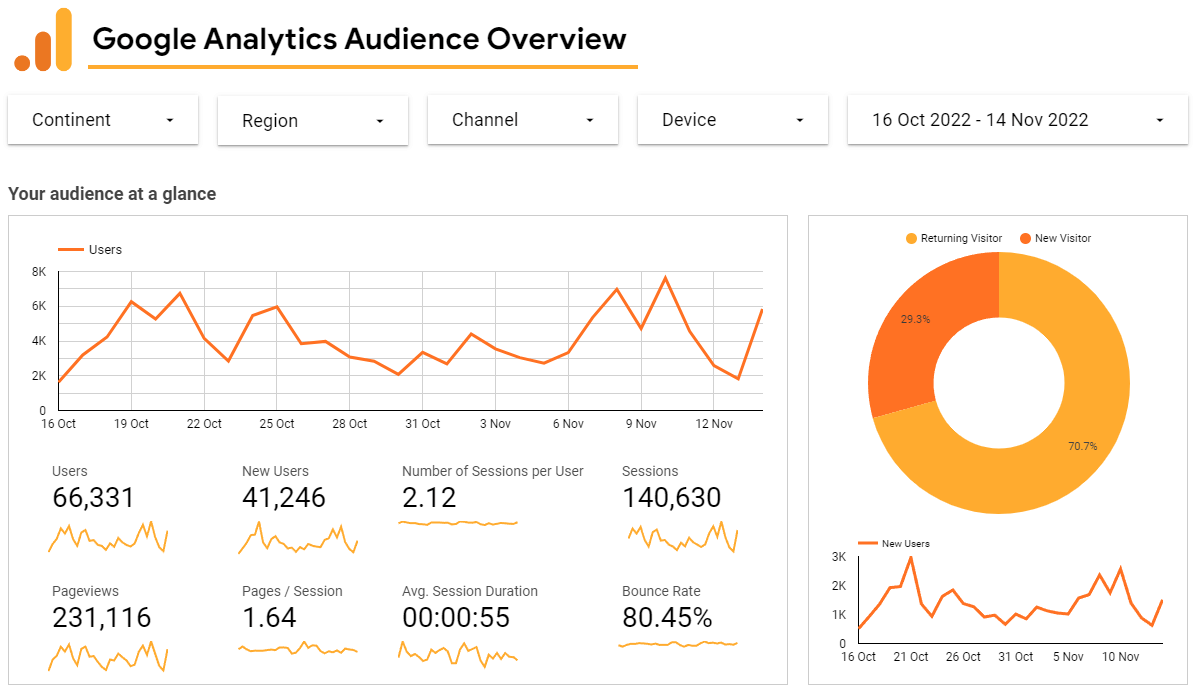Getting a website off the ground can be daunting, but it’s also exciting. You’ve got the opportunity to show people what you’re capable of, and you want to make sure they see it—that they love it and come back for more. But how do you know what to track? Which metrics matter most? Well, that depends on your goals for your site. To help clarify which webshop metrics are most important for different types of sites, we’ve broken down the most important of them.
Site Traffic
Generally, site traffic is the number of visits to your website from people interested in your products and services. Businesses measure site traffic to see how well their marketing campaigns are performing and to understand how to improve their product offerings. But this is not all. Site traffic is a combination of metrics such as how many pages visitors view and how long they stay on your site. This data can help you identify user behavior patterns that indicate high-quality content, or landing page optimizations that are working. Site traffic can answer the most important questions for your website such as “What pages do visitors visit (what search terms do they use)? Where do these visitors come from? How many visits come from organic search and how many come from social media sites like Facebook or Twitter?”
These metrics give you valuable insight into how people interact with and use your website. This data also helps you compare your own website to other websites, brands, and companies in your market. Analytics is the best way to see what works (and doesn’t) on your website. Site traffic can be an important indicator of how the SEO strategy of your online shop is working.
Conversion Metrics
The most important metric you need to track is your conversion rate. This is the percentage of people who take the desired action on your site, such as purchasing a product or signing up for an account. If you have a website that sells products, then the goal would be to increase this number by improving your site’s design and UX (user experience).
Conversion rate optimization (CRO) is the process of improving this number by testing different variations of elements on your page — like button colors or call-to-action text — until you find one that works best with your target audience. You can do this on any website using Google Analytics; just look under “Conversions” in its reporting section and see which pages are leading to conversions (or not).
You also need to know what the cost per conversion is so that you know if it’s worth making changes on those pages or not. For example: If each purchase costs $10 in advertising fees but brings in $50 in revenue, then we’re looking at a 5X return on investment—that might be worth tweaking our ads! But if each purchase costs $5 but brings no new leads into our sales funnel? Not so much…
Bounce rate
Bounce rate is the percentage of visitors who viewed only one page on your website before leaving. This metric measures how useful and valuable your content is to your visitors. A large bounce rate can be a sign of poorly designed landing pages, bad information architecture, or unclear calls to action. Bounce rate metrics are an important part of a site’s analytics and can tell you whether or not your site is converting visitors, keeping them on the page, and driving them to desired outcomes.

The Keyword Metrics
-
Keyword difficulty score: This metric tells you how difficult it is for a user to find your content when searching for the keyword that best matches the content. The higher this number, the more difficult it will be for users to find your page.
-
Keyword ranking: This shows where your page ranks when someone searches for a specific keyword. A higher ranking means that users are more likely to see your page before they see other pages, which can increase traffic and conversions on your site. If a competitor has higher rankings than you do, then they’re getting more visibility and traffic than you are!
-
Keyword volume: How many people search Google each month using keywords related to what you offer? This metric helps you understand the potential reach of different keywords within search engines like Google. It also helps determine which ones might be better suited for marketing campaigns or paid advertising efforts (like AdWords).
Competitor Metrics
You need to know who your competitors are and what they are doing in order to make informed decisions about how you want to grow and improve as a business. Competition metrics are essential because they help you to understand how you stack up against your competitors. You can use them to identify opportunities by seeing where your competitors are falling short or succeeding over time.
Backlink Metrics
Backlink metrics are important because they show you how well your site is ranking in search engines. The more backlinks you have, the better your site will rank. They’re also important because they tell you how well your content is performing; if people are linking to your article/video/website/whatever, it means that people like what you do and want others to see it too.
Now, what does this all mean for you?
If you’re looking to get started tracking website metrics, the most important thing to remember is that you don’t need to be tracking them all. In fact, if you’re new to websites and analytics in general, it can be overwhelming if you try and track everything at once. So instead of trying to understand every single metric on the list above (and there are tons more), focus on just a few key metrics that will help provide insight into your business’s overall performance:
-
Number of visitors per month/year
-
Average time spent on site per visitor (minutes)
-
Bounce rate
In Conclusion
Good website metrics help you optimize your site and keep it running smoothly. They can also help you understand where your audience is coming from and what they like about your content. It’s important to remember that the best way to find out which metric(s) are right for you is by testing them!

